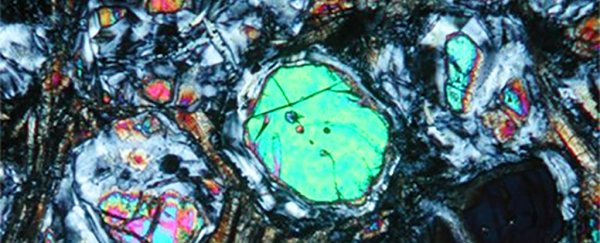Scientists are using minerals extracted from volcanic rock to learn more about the earliest times on planet Earth – those first 1.5 billion years of our world that we don't really know much about.
Rock records with reasonable accuracy stretch back about 3 billion years, and as Earth is around 4.5 billion years old, there are some gaps in our knowledge. A rock called komatiite might be able to fill those gaps in for us.
A team from Louisiana State University has been mapping komatiite in the Barberton or Makhonjwa mountains of South Africa for more than 30 years, and has now reported crucial differences between its composition and that of more modern rock samples, perhaps giving us a look back at how the Earth's mantle originally looked.
Hundreds of komatiite rocks, taken from around 10 lava flows, were analysed in the course of the research, and fresh samples of a mineral called olivine were discovered, preserved in unusual detail.
This olivine makes up a lot of the Earth's mantle but rarely makes its way to the surface due to a whole host of geological and weathering pressures. That means these mountains hold some of the most well-preserved rock records of the early Earth that we've got.
What's more, olivine is partly responsible for volcanic and tectonic activity on the surface, and can log a record of what's happened on the surface and below it in the past – maybe even during the Archean eon, starting some 4 billion years ago.
"Discovering fresh unaltered olivine in these ancient lavas was a remarkable find," says one of the researchers, Keena Kareem.
"The field work was wonderfully productive and we were eager to return to the lab to use the chemistry of these preserved olivine crystals to reveal clues of the Archean mantle."
By identifying the isotopic signature of the oxygen in the minerals – the mix of neutrons in the atoms of an element, and therefore the type of oxygen that was around – scientists can estimate temperatures from billions of years ago.
In this case, studying the oxygen isotopes of the olivine turned up evidence that an ocean of magma was floating over the surface of our planet more than 3 billion years ago, which would form a crucial part of Earth's early evolution and even the origins of life.
"It became apparent that these rocks preserve signatures of processes that occurred over four billion years ago and that are still not completely understood," says one of the team, Benjamin Byerly.
It's still too early to say exactly what it would've been like to stand on the surface of Earth during those first 1.5 billion years, but this rock find and the oxygen records embedded in it could prove to be vital clues.
The earliest fossils we have suggest life started sprouting up just under 4 billion years ago, which means these opening chapters in Earth's history are likely to be when the first building blocks of life were stacked up in the right order.
We're looking forward to what these most ancient of rocks are going to reveal next.
The research has been published in Nature Geoscience.
